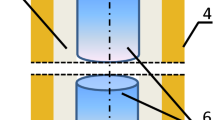Abstract
In order to prepare high strength plaster molds for investment casting, polypropylene and aluminum silicate hybrid fibers of contents 0.50 wt% were introduced into powder mixture of gypsum and mullite. The effects of different ball milling times on strengths of plaster molds were investigated in this work. To this end, modified mullite and gypsum powder were mixed and treated by ball milling for 2.0–8.0 min. The hybrid fibers were added to the solid mixture to prepare reinforced plaster molds with high strengths. The green, fired, and residual strengths of plaster mold specimens were all tested. The results showed a positive effect of ball milling on the strengths of plaster molds, in which strength could effectively be improved by raising the ball-milled time regardless of the presence or absence of the fiber. The strength increased by at least 29.7% when compared to un-milled specimen. However, the ball milling time should not be too long since exceeding 6.0 min resulted in a slow declining trend of the strength of the plaster molds until reaching a stable plateau. Shorter ball milling periods could refine the crystal size of refractory materials. For green specimens, the morphology of plaster crystal changed from short rods to fine needles and then to column crystals as milled time rose, promoting changes in strength. The microscopic morphologies of fired specimens were slightly impacted by the increase in milling time. Overall, ball milling periods of 4.0–6.0 min were identified as optimum for fiber-reinforced plaster molds. These findings look promising for future preparation of solid shell for investment casting.









Similar content being viewed by others
References
Udaykumar V. Saindane, Sandeep Soni, Jyoti V. Menghani, Recent research status on synthesis and characterization of natural fibers reinforced polymer composites and modern friction materials—an overview. Mater. Today 26, 1616–1620 (2020)
Xu Mingzhi, Jingjing Qing, Effect of firing temperature and duration on fused silica investment shell strength at room temperature. Int. J. Metalcast. 13, 923–927 (2019). https://doi.org/10.1007/s40962-019-00312-5
Sarojrani Pattnaik, Mihir Kumar Sutar, Effect of saw dust content on slurry rheology and mechanical properties of the investment casting ceramic shell. Int. J. Metalcast. (2020). https://doi.org/10.1007/s-020-00478-3
D. Sanjay Kumar, Benny Karunakar, Enhancing the permeability and properties of ceramic shell in investment casting process using ABS powder and needle coke. Int. J. Metalcast. 13, 588–596 (2019). https://doi.org/10.1007/s40962-018-00297-7
P.K. Panigrahy, G. Goswami, J.D. Pand et al., Differential comminution of gypsum in cements ground in different mills. Cement Concr. Res. 33, 945–947 (2003)
T. Sievert, A. Wolter, N.B. Singh, Hydration of anhydrite of gypsum (CaSO4.II) in a ball mill. Cement Concr. Res. 35, 623–630 (2005)
N. Kotake, K. Suzuki, S. Asahi et al., Experimental study on the grinding rate constant of solid materials in a ball mill. Powder Technol. 122, 101–108 (2002)
Yanfen Li, Xiangdong Liu, Lu Kai et al., Preparation of fiber-reinforced shell by airflow placement fiber technology for investment casting. Int. J. Metalcast. 13(4), 979–986 (2019). https://doi.org/10.1007/s40962-019-00323-2
S. Jones, C. Yuan, Advances in shell moulding for investment casting. J Mater Process Tech. 135(2–3), 258–265 (2003)
Lu Gang, Song Fangrui, Yan Qingsong et al., Effects of polyamide 66 fibers added to corundum sand on properties of composite shell. Acta Mater Compos Sin. 37(4), 927–934 (2020)
Kai Lü, Zehai Duan, Xiangdong Liu et al., Effects of fibre length and mixing routes on fibre reinforced shell for investment casting. Ceram. Int. 45, 6925–6930 (2019)
Bilge Öksüzoðlu, Metin Uçurum, An experimental study on the ultra-fine grinding of gypsum ore in a dry ball mill. Powder Technol. 291, 186–192 (2016)
A.E. Basam, Ben-Arfa, Isabel M. Miranda Salvado, Robert C. Pullar et al., The influence of processing parameters on morphology and granulometry of a wet-milled sol-gel glass powder. Ceram. Int. 44, 12754–12762 (2018)
Guo-jian Jing, Zheng-mao Ye, Cheng Li et al., A ball milling strategy to disperse graphene oxide in cement composites. New Carbon Mater. 34(6), 569–577 (2019)
Fabio Iucolano, Domenico Caputo, Flavio Leboffe et al., Mechanical behavior of plaster reinforced with abaca fibers. Constr. Build. Mater. 99, 184–191 (2015)
G. Di Bella, V. Fiore, G. Galtieri et al., Effects of natural fibres reinforcement in lime plasters (kenaf and sisal vs. Polypropylene). Constr. Build. Mater. 58, 159–165 (2014)
Cheng Yuan, Wensu Chen, Thong M. Pham et al., Bond behavior between basalt fibres reinforced polymer sheets and steel fibres reinforced concrete. Eng. Struct. 176, 812–824 (2018)
Sutapa Deb, Nilanjan Mitra, Subhasish Basu Majumder et al., Improvement in tensile and flexural ductility with the addition of different types of polypropylene fibers in cementitious composites. Constr. Build. Mater. 180, 405–411 (2018)
M.I.J. Ibrahima, S.M. Sapuana, E.S. Zainudina et al., Preparation and characterization of cornhusk/sugar palm fiber reinforced cornstarch-based hybrid composites. J Mater Res Technol. 9(1), 200–211 (2020)
M. Sophia, N. Sakthieswaran, Synergistic effect of mineral admixture and bio-carbonate fillers on the physico-mechanical properties of gypsum plaster. Constr. Build. Mater. 204, 419–439 (2019)
Acknowledgement
This work was financially supported by the Natural Science Foundation of Inner Mongolia Autonomous Region (Grant No. 2020MS05024), Inner Mongolia Science & Technology Plan (under the contracts No. 201502014).
Author information
Authors and Affiliations
Corresponding author
Additional information
Publisher's Note
Springer Nature remains neutral with regard to jurisdictional claims in published maps and institutional affiliations.
Rights and permissions
About this article
Cite this article
Lu, Y., Liu, X., Li, Y. et al. Effect of Ball Milling Time on Strengths of Hybrid Fiber-reinforced Plaster Molds for Investment Casting. Inter Metalcast 15, 864–873 (2021). https://doi.org/10.1007/s40962-020-00522-2
Received:
Accepted:
Published:
Issue Date:
DOI: https://doi.org/10.1007/s40962-020-00522-2




